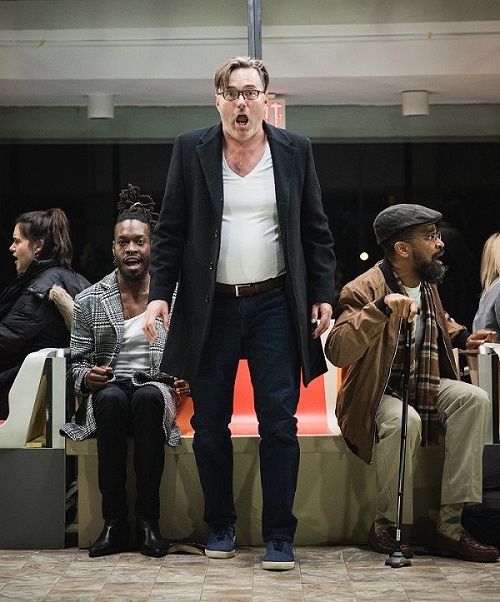IN Series’ amalgam of love and death strikes a surreal note of remembrance

(L to R) Aryssa Leigh Burrs, Daniel J. Smith, Oliver Mercer, and Jarrod Lee in Requiem, presented by IN Series Friday night at Hand Chapel. Photo: Bayou Elom
IN Series returned on Friday night to Hand Chapel, on the campus of Mount Vernon College, for the opening of a quirky new mashup of Mozart’s Requiem with music by Claude Vivier and Lili Boulanger. The venue was the longtime home of IN Series, under its founding director, Carla Hübner, until a change in university administration forced the company to seek new homes elsewhere.
Artistic director Timothy Nelson, who directed this production, used the occasion to mark the series’ 40th anniversary with a bold pronouncement. The Requiem, which IN Series had never performed before, will be the company’s “farewell to Mozart, as we look with anticipation to the space open to others that this allows.” Nelson confirmed in an email the company’s public intention to invest in underrepresented composers by no longer performing Mozart’s music.
“What you’re about to see,” as Nelson put it in his spoken introduction to the hour-long performance, “is weird.” When Nelson, whose productions have provoked and puzzled viewers over the years, says that, viewers should be forewarned. But for those willing to tolerate his experimental approach, Nelson’s narrative of death and transcendence can be powerful, especially in November, a month set aside for the commemoration of the dead in the Catholic tradition.
The evening opened with Claude Vivier’s Jesus erbarme dich (Have mercy on me, Jesus), a piece for soprano and choir, composed just before the composer returned to his native Québéc after studies in Europe. An ensemble of seven singers, seated initially among the audience in the pews, gathered in the chapel’s central space, covered by a silvery cloth framed with lights, completing this remarkably dissonant, enigmatic piece.
The singers seemed to be standing on a subway platform, reading books and looking at their phones, until a train arrived. They entered the “train,” represented by a stationary box enclosed by bars and containing brightly colored seats, and soon appeared to be involved in some sort of accident. What happened afterwards was perhaps the fever dream they experienced following their deaths.
For most of the performance, sections of Mozart’s Requiem were interspersed with parts of Vivier’s Love Songs, a score written to accompany a 1977 ballet created by the Québecois dance ensemble Le Groupe de la Place Royale. Since the dancers were to sing the music as they danced, Vivier used a simplified form of notation, indicating relative pitches and leaving many of the rhythmic details and textures to improvisation.
Nelson, music director Emily Baltzer, and David E. Chavez accompanied the Mozart movements on three synthesizers from the balcony overlooking the sanctuary, with Chavez credited for the musical arrangement. These canned sounds of strings and winds received emphatic punctuation from percussionist Michael Barranco, wielding bells, drums, and cymbals. A small choir of five singers reinforced the stage ensemble in the Requiem movements, creating an enveloping sonic effect.
The vocal and instrumental forces were not ideally suited to the demands of Mozart’s Requiem, held together by Baltzer’s emphatic conducting, but this celebrated score mitigated the oddities of Vivier’s music, making it more digestible than it would be on its own. The seven singers did extraordinary work to bring it to life in sound and movement, not least in the dizzying range of texts, taken from Wagner’s Tristan und Isolde, Shakespeare’s Romeo and Juliet, the Latin Requiem Mass (an apt connection), and in Vivier’s own invented languages. Adding to the macaronic jumble of languages, the Mozart Requiem was sung in a mix of the original Latin and English translation.
The Vivier work’s eccentricities felt of a piece with Hand Chapel itself, also built in the 1970s and very much of its time period. Vocalizations combined with whistling, finger-assisted lip trills, and other curious effects, adding to the sense of the children’s games the ensemble acted out. This child-like regression of the characters contrasted with the weighty pleas for God’s merciful judgment, especially in Mozart’s extended setting of the “Dies Irae” sequence.
It made perfect sense to end the Requiem with the “Lacrimosa” movement, stopping after eight measures, at the point where Mozart died, leaving the work incomplete. At that point, most of the singers left the stage, mounting the stairs to the balcony to join the choir there. Although Love Songs is a complete work, Nelson drew another parallel to the Mozart Requiem by concluding the evening with Vivier’s Glaubst du an die Unsterblichkeit der Seele? (Do you believe in the immortality of the soul?), a work Vivier left incomplete at the time of his horrific murder in Paris.
Tenor Oliver Mercer took the lead vocal part, singing with impressive force and subtlety. A narrator’s text, spoken by someone on the balcony, related a semi-autobiographical, violent episode on the Paris subway. Vivier wrote the piece for three synthesizers and glockenspiel accompanying twelve voices, the unusual instrumentation that determined the forces for the entire evening.
Soprano Teresa Ferrara stood out for her solo part in the final piece of the evening, Pie Jesu, composed by Lili Boulanger just before she succumbed to tuberculosis at 24, the youngest of this trio of composers who all died far too young. Perhaps the beginning of Lili’s own Requiem Mass, this final couplet of the “Dies Irae” chant served as an ideal postscript. The departed singers returned to the stage, as the piece reached its conclusion, and then took their seats again among the audience.
Requiem runs through November 20, at five different venues. inseries.org


Posted Nov 07, 2022 at 8:19 am by John Driscoll
I saw this at the Dupont Underground, where the subway car setting was even more appropriate. The chorus was in the row behind me, and, in combination with the acoustics of the space, that made it feel like the music surrounded me. It was unforgettable and weird in a good way.
Thank for for reviewing this performance. As part of its efforts to be a national newspaper, the Post is splitting its single classical music critic between Washington and elsewhere (it is doing the same for theater, but also has some local-only critics). As a result, it’s not reviewing many local performances, especially those by smaller ensembles.
I find written criticism like yours helps me evaluate what I have seen and decide what I will see. Social media isn’t a good substitute for that, and if more traditional criticism eventually disappears I wonder how I’ll find new things to see. I can try to take more chances, but that’s time consuming.
Posted Nov 09, 2022 at 2:41 pm by Inna Stavitsky
Wonderful Thank you!